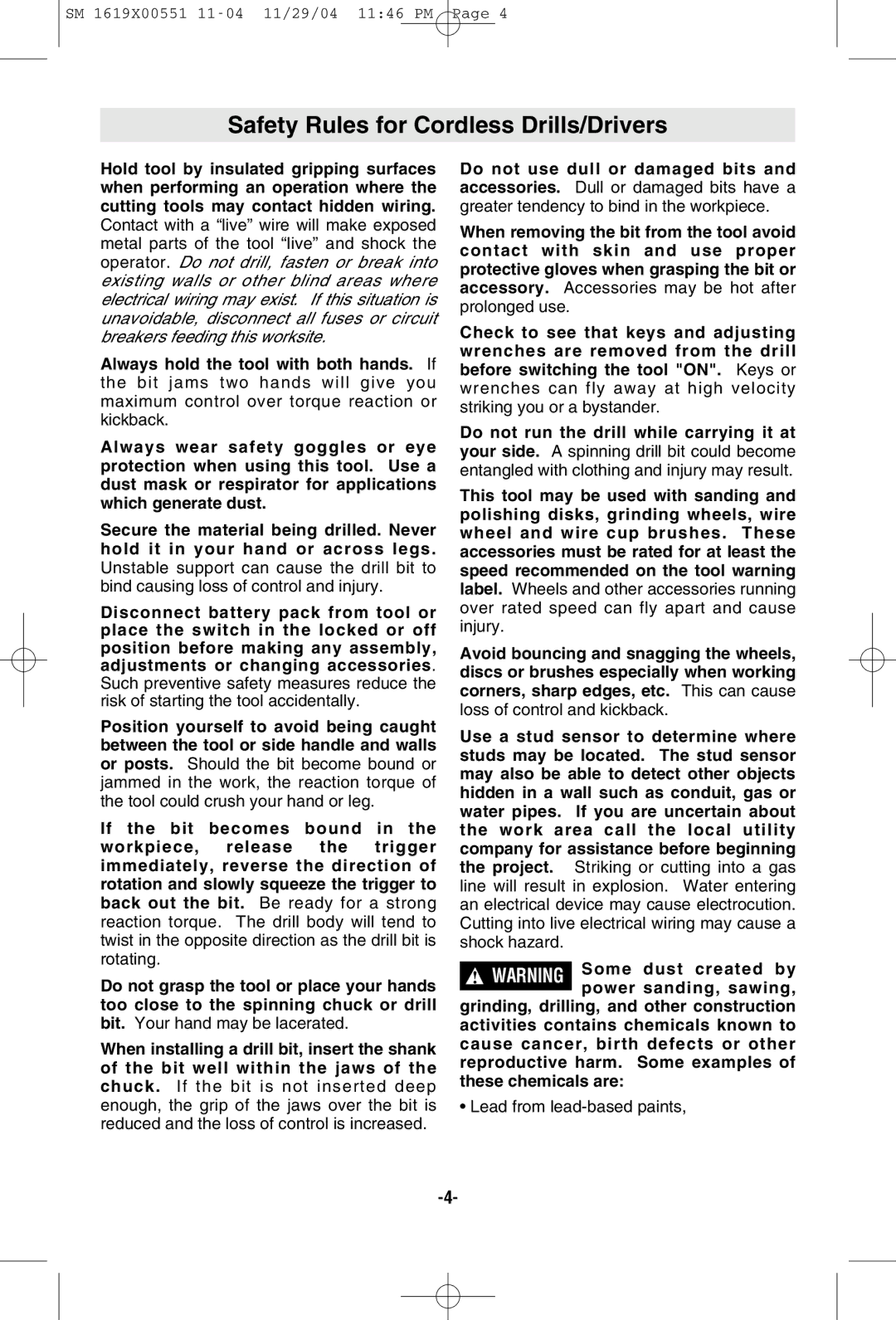
SM 1619X00551
Safety Rules for Cordless Drills/Drivers
Hold tool by insulated gripping surfaces when performing an operation where the cutting tools may contact hidden wiring.
Contact with a “live” wire will make exposed metal parts of the tool “live” and shock the operator. Do not drill, fasten or break into existing walls or other blind areas where electrical wiring may exist. If this situation is unavoidable, disconnect all fuses or circuit breakers feeding this worksite.
Always hold the tool with both hands. If the bit jams two hands will give you maximum control over torque reaction or kickback.
Always wear safety goggles or eye protection when using this tool. Use a dust mask or respirator for applications which generate dust.
Secure the material being drilled. Never hold it in your hand or across legs.
Unstable support can cause the drill bit to bind causing loss of control and injury.
Disconnect battery pack from tool or place the switch in the locked or off position before making any assembly, adjustments or changing accessories. Such preventive safety measures reduce the risk of starting the tool accidentally.
Position yourself to avoid being caught between the tool or side handle and walls or posts. Should the bit become bound or jammed in the work, the reaction torque of the tool could crush your hand or leg.
If the bit becomes bound in the workpiece, release the trigger immediately, reverse the direction of rotation and slowly squeeze the trigger to back out the bit. Be ready for a strong reaction torque. The drill body will tend to twist in the opposite direction as the drill bit is rotating.
Do not grasp the tool or place your hands too close to the spinning chuck or drill bit. Your hand may be lacerated.
When installing a drill bit, insert the shank of the bit well within the jaws of the chuck. If the bit is not inserted deep enough, the grip of the jaws over the bit is reduced and the loss of control is increased.
Do not use dull or damaged bits and accessories. Dull or damaged bits have a greater tendency to bind in the workpiece.
When removing the bit from the tool avoid contact with skin and use proper protective gloves when grasping the bit or accessory. Accessories may be hot after prolonged use.
Check to see that keys and adjusting wrenches are removed from the drill before switching the tool "ON". Keys or wrenches can fly away at high velocity striking you or a bystander.
Do not run the drill while carrying it at your side. A spinning drill bit could become entangled with clothing and injury may result.
This tool may be used with sanding and polishing disks, grinding wheels, wire wheel and wire cup brushes. These accessories must be rated for at least the speed recommended on the tool warning label. Wheels and other accessories running over rated speed can fly apart and cause injury.
Avoid bouncing and snagging the wheels, discs or brushes especially when working corners, sharp edges, etc. This can cause
loss of control and kickback.
Use a stud sensor to determine where studs may be located. The stud sensor may also be able to detect other objects hidden in a wall such as conduit, gas or water pipes. If you are uncertain about the work area call the local utility company for assistance before beginning the project. Striking or cutting into a gas line will result in explosion. Water entering an electrical device may cause electrocution. Cutting into live electrical wiring may cause a shock hazard.
!WARNING Some dust created by power sanding, sawing,
grinding, drilling, and other construction activities contains chemicals known to cause cancer, birth defects or other reproductive harm. Some examples of these chemicals are:
